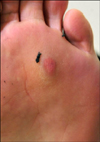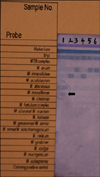Abstract
Mycobacterium massiliense which is recognized as a separate species from M. abscessus is little known regarding its clinical patterns and the response to treatment. We present a case of a localized cutaneous infection due to M. massiliense of the sole associated with acupuncture. M. massiliense was identified via polymerase chain reaction-hybridization analysis. We treated the patient with single-drug therapy consisting of clarithromycin for 4 months and the patient showed a significant response to this treatment.
Nontuberculous mycobacterium (NTM) is a ubiquitous environmental organism that is progressively recognized as a human pathogen. It is unusual for it to cause a true infection, but it can be an important cause of cutaneous infections especially in immunocompromised patients and after invasive procedures such as acupuncture or minor surgery.
Mycobacterium massiliense was first described by Adékambi et al.1 in 2004, and it was firstly isolated from the sputum of a patient with pneumonia. This new species is closely related to the M. abscessus/chelonae group. However, M. massiliense has not been completely understood, and it has been suggested that this species may be different from other mycobacterial infections in its therapeutic response to antimicrobial agents2.
In February 2011, a 45-year-old male visited our hospital with a painful nodule on his left sole that had appeared four weeks ago. Before visiting our outpatient clinic, he had undergone acupuncture on his back and both extremities including the soles and palms to alleviate chronic back pain. The skin lesion on his left sole developed after a few weeks of receiving acupuncture. On physical examination, the patient showed an erythematous subcutaneous nodule with local tenderness and heat on the sole of his left foot (Fig. 1). There was no discharge or fluctuation. No systemic symptoms including fever were detected.
Histological examination of a biopsy obtained from the lesion on his sole showed granulomatous inflammation with neutrophilic microabscesses in the dermis and subcutaneous fat tissue. No special staining was performed (Fig. 2).
A Gram stain and a culture of the tissue specimens to identify the bacterial infection revealed negative results. Acid-fast bacili culture of the tissue specimen on liquid media (Mycobacterium growth indicator tube: middle block 7H9 broth agar) and 3% Ogawa solid media at 25℃ to 30℃ and 37℃ was done. Numerous colonies were observed after 1 week of culture on liquid media at 37℃ (Fig. 3). For identification of the mycobacterium species, polymerase chain reaction-hybridization (REBA Myco-ID®, M&D Inc., Wonju, Korea) was performed. We used a molecular diagnostic kit designed to identify 19 species of NTM by binding the amplifying rpo B gene product to a species-specific probe. Then the culture was identified as M. massiliense (Fig. 4). Susceptibility testing for antibiotics was done using the broth microdilution method according to the criteria of the Clinical and Laboratory Standards Institute. The isolate was susceptible to clarithromycin (minimum inhibitory concentration≤0.5µg/ml) and it showed intermediate susceptibility to amikacin and cefoxitin. However, the isolate was resistant to ciprofloxacin and doxycycline.
Because we at first considered his cutaneous lesion to be an abscess or inflammation due to a ruptured epidermal cyst, he received empirical antibiotic treatment with cefadroxil for 2 weeks. And then, based on the susceptibility results, we treated the patient with clarithromycin 100 mg a day for 4 months, and he showed improvement of both his subjective symptoms and his cutaneous lesion.
In recent years, nonmycobacterial infections have emerged as an important issue. Along with the increase in the number of people with immunosuppressive states over the past few decades, the incidence of nonmycobacterial infections has increased worldwide. Also, the occurrence of nonmycobacterial infections is usually related to surgical procedures, injections or minor trauma. Acupuncture is widely performed in Asia, especially as these kinds of infections are usually epidemic in this region.
M. massiliense was first described as a novel species from the M. abscessus and M. chelonae groups1. 16S rRNA gene sequence analysis is used for distinguishing nontuberculosis mycobacteria. But the 16S rRNA gene of M. massiliense is fully identical with that of M. abcessus, and more than 99.6% of it is identical with the M. chelonae and M. immunogenum genes3. Thus, M. massiliense can be differentiated from other organisms by the sequencing of the rpoB, sod A, hsp65 and recA genes or the 16S~23S rRNA internal transcribed spacer sequence3,4. The isolation of M. massiliense has been reported in recent years according to the development of a diagnostic test. It is thought that many NTM infections previously diagnosed with M. absecessus or M. chelonae are actually infections caused by M. massiliense.
Based on the published reports, an outbreak of M. massiliense infection associated with intramuscular injections at a local clinic in Korea was reported5. The incidence of M. massiliense infections in Korea is higher than that in other countries6,7. This prevalence of M. massiliense may be due to its viability in different types of environments, and its diverse resistance patterns to antimicrobial agents.
It is usually difficult to diagnose cutaneous NTM infections because of the variety of clinical manifestations affected patients present with as well as the frequent false-negative culture results they show. More sensitive detection tools such as polymerase chain reaction (PCR)-restriction fragment length polymorphism and PCR-hydridization are helpful for diagnosing NTM infections. In our present case, the lesion on the sole of the foot made the diagnosis difficult. Because NTM lesions of the sole are rare despite the high variability of the features of NTM infections, the lesion of the patient was regarded as an abscess or a ruptured epidermal cyst at first.
The treatment of cutaneous NTM infections depends on the immune status of the infected host, the extent of the disease and the susceptibility to antimicrobial agents8. Since there is no established standard therapy against M. massiliense, the treatment of M. massiliense infections is usually empirically selected. M. massiliense does not show a uniform pattern of resistance to doxycycline in many reported cases compared to other NTM species including M. abscessus4,7. Also, the response rates to combination antibiotic therapies including those containing clarithromycin were much higher in patients with M. massiliense lung disease than in those with M. abscessus lung disease2. Most of the previous cases of M. massiliense infection are treated with combination therapy including therapy containing clarithromycin3,4. Unlike previous studies, we treated the patient with single-drug therapy consisting of clarithromycin, and at present, he is showing good recovery.
This is the third report of a localized skin infection of M. massiliense in Korea (Table 1)4,5. Also, it is relatively rare for NTM infections to occur on the sole of the feet. M. massiliense would seem to have different response patterns to antibiotic treatment distinct from other NTM species. Thus, further study is required to verify the clinical features and treatment options for M. massiliense infections.
Figures and Tables
Fig. 2
(A) Mixed inflammatory cellular infiltration with granuloma in the dermis and subcutaneous layer (H&E, ×100). (B) Multinucleated giant cells are seen in the dermis (H&E, ×400).

Fig. 3
Ivory-to-yellowish colored smooth colonies on the liquid media at 37℃ after 7 days of culture.

References
1. Adékambi T, Reynaud-Gaubert M, Greub G, Gevaudan MJ, La Scola B, Raoult D, et al. Amoebal coculture of "Mycobacterium massiliense" sp. nov. from the sputum of a patient with hemoptoic pneumonia. J Clin Microbiol. 2004; 42:5493–5501.
2. Koh WJ, Jeon K, Lee NY, Kim BJ, Kook YH, Lee SH, et al. Clinical significance of differentiation of Mycobacterium massiliense from Mycobacterium abscessus. Am J Respir Crit Care Med. 2011; 183:405–410.

3. Nakanaga K, Hoshino Y, Era Y, Matsumoto K, Kanazawa Y, Tomita A, et al. Multiple cases of cutaneous Mycobacterium massiliense infection in a "hot spa" in Japan. J Clin Microbiol. 2011; 49:613–617.

4. Cho AY, Kim YS, Kook YH, Kim SO, Back SJ, Seo YJ, et al. Identification of cutaneous Mycobacterium massiliense infections associated with repeated surgical procedures. Ann Dermatol. 2010; 22:114–118.

5. Kim HY, Yun YJ, Park CG, Lee DH, Cho YK, Park BJ, et al. Outbreak of Mycobacterium massiliense infection associated with intramuscular injections. J Clin Microbiol. 2007; 45:3127–3130.

6. Kim BJ, Lee SH, Lyu MA, Kim SJ, Bai GH, Kim SJ, et al. Identification of mycobacterial species by comparative sequence analysis of the RNA polymerase gene (rpoB). J Clin Microbiol. 1999; 37:1714–1720.





 PDF
PDF ePub
ePub Citation
Citation Print
Print






 XML Download
XML Download